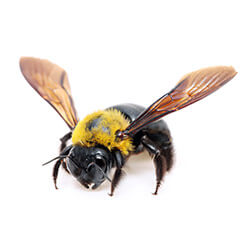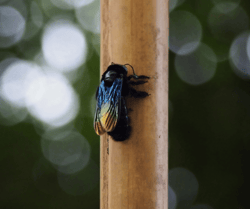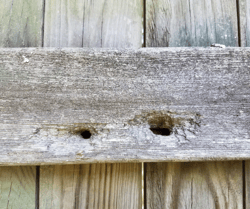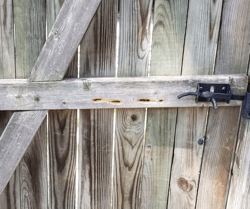
Carpenter bees
Carpenter bees are of the broad Xylocopa genus, which is made up of roughly 500 different bee species and 31 subgenera. Aptly named, carpenter bees were dubbed such due to their wood-burrowing nesting habits. Nearly all species in this genus bore into hard plant material with very few outliers who instead build tunnels in soil. The genus of carpenter bees was named by French entomologist Pierre André Latreille who used the Greek word for “woodcutter” as its derivative.
Contrary to popular belief, carpenter bees do not eat the wood they bore into. Instead, the wood is drilled into to create a vast maze of tunnels and a nesting system. Unlike other common bee species, carpenter bees don’t live in colonies. They are not social insects and tend to live in solitude, creating individual nests in trees or worse, the frame, eaves, or siding of your home. Female carpenter bees will also use these tunnels – referred to as “galleries” – for egg-laying, allowing her young to remain protected from predators and the elements.
Schedule a FREE Estimate
How Do I Identify Carpenter Bees?
Carpenter bees are often difficult to identify due to their appearance closely resembling other bee species, particularly bumblebees. In fact, bumblebees and carpenter bees are the two largest bee species that are native to the United States. While they look very similar, there are a few key differences that help professionals tell them apart. Carpenter bees don’t have the same hairy yellow markings on their abdomens that bumblebees do; instead, carpenter bees’ abdomens are smooth and shiny. They also often have blackish-blue abdomens and/or wings and tend to be larger than the average bumblebee.
Female carpenter bees can be easily distinguished from males by their black heads. Male carpenter bees’ heads are also predominantly black, but they have noticeable white markings near the front of their head.

HOW DO CARPENTER BEES DAMAGE MY HOME?
Carpenter bee damage often starts as small, one-inch-deep entry holes in key areas of your home. They are particularly drawn to softer, untreated wood such as structural framing, eaves, unpainted or non-stained siding, along with other home-related structures such as fences, barns, sheds, or carports. Unfortunately, carpenter bee damage rarely stops at a few small entry holes.
Carpenter bees then construct perpendicular tunnel off-shoots from these entry points that can be up to 8 inches long. These entry holes and tunnels are called galleries, and they can often be quite extensive. Female carpenter bees may build between 6-8 of these tunnels for egg-laying purposes. Sometimes, the tunnels aren’t visible at all from the outside and the only indication of the presence of carpenter bees may be the small entry holes initially drilled.
That may not sound too disastrous until you consider that many female carpenter bees will return to existing galleries for several consecutive years. Each year, the same pattern of tunnel drilling will repeat, compounding damage and creating significant fault lines in the wooden structures. Over the years, tunnels that started as just a few inches in size can expand to 10 feet in length. If untreated, this can cause considerable damage to your home’s integrity and stability.
Another concern regarding carpenter bee damage is the unsightly staining they often leave behind. Because the bees work, live, and sleep in the tunnels they’ve constructed, they also leave behind their excrement there. This excrement leads to dark, unattractive staining on the infested structure. Yes – the carpenter bee’s poop stains your home!
 Carpenter bee entry holes
Carpenter bee entry holes
HOW DO I KNOW IF I HAVE CARPENTER BEES?
Carpenter bees aren’t always evident in their infestation of your home or additional structures. Especially in the beginning stages, it can be difficult to identify the presence of carpenter bees. Here are a few things to look out for this spring and summer:
- You see a carpenter bee. This might seem obvious, but it becomes less so when you consider that carpenter bees are easily confused for bumblebees. If you’re uncertain that the bee you’ve encountered is a carpenter bee, consider its behavior. Carpenter bees will be hanging around wooden structures such as your home’s soffits or eaves, whereas bumblebees build nests in the ground and remain nearby, buzzing about flower beds and other low plants.
- You hear a carpenter bee. Carpenter bees can be surprisingly noisy in their wood-boring and tunnel-building. You may hear a buzzing, humming, or vibrating sound from inside or outside your home.
- You see smooth, round holes in wood structures. These holes may be indicative of carpenter bee entry holes.
- You notice staining on wood structures. Carpenter bees will excrete as they work and these droppings will often result in dark, drip-like stains. Depending on the lightness of the wood, these stains may also look yellowish in color.
- You see small piles of sawdust. As carpenter bees bore into wood, small piles of frass or sawdust may accumulate below the drill site. Sawdust may also appear in a line following the bee’s drilling direction.
- Your wooden structures give way. Hopefully, your carpenter bee infestation would be discovered before this level of damage can occur, but if all signs are missed for a few years, damage to structures can accumulate to the point of giving way. This may result in split structural supports, snapped fence posts, or splintered railings. If any wooden structures on or around your home break, be sure to inspect it closely for holes and tunneling.
 Carpenter bee tunnels
Carpenter bee tunnels
CAN I PREVENT CARPENTER BEES?
At EcoShield, we believe prevention is always the best approach to pest control. While preventing carpenter bees entirely can be tricky, there are several ways to make your home less hospitable to carpenter bees.
- Paint or stain exposed wood. Carpenter bees prefer untreated wood, so painting or staining exposed wood structures may deter them from nesting.
- Fill abandoned holes. Carpenter bees are known to return to old nesting sites, so by filling entry holes to old nests, you may prevent them from being able to renest in an existing site.
- Use vinyl home siding. If possible, use vinyl siding for your home as it protects the wood beneath it and acts as a deterrent to carpenter bees.
- Install a carpenter bee hotel. These structures are specifically built with pre-drilled holes to appeal to carpenter bees and encourage them to nest in the provided structure rather than your property.
- Hire a trusted pest professional like EcoShield. A trusted pro can offer custom treatment plans and expert guidance in preventing carpenter bees from infesting your home. They can help identify potential problem areas and even point out signs of existing carpenter bee damage.
Carpenter bee entering its nest
Frequently Asked Questions
Why are there woodpeckers pecking my house?
Woodpeckers are primarily insectivorous, and they may peck at houses to search for insects or other arthropods that may be hiding in the wood or crevices of the structure. They use their strong beaks to create holes and excavate insect galleries, which can provide them with a food source. This is especially common in homes with carpenter bee infestations as woodpeckers are attracted to the carpenter bee’s larva... Read More
What's the difference between carpenter bees and bumblebees?
As spring settles and the outdoors comes alive again, you might notice a steady rise in buzzing insects. For homeowners, this can be an unnerving experience. Due to the many different bee and stinging insect species that exist, it’s not a surprise that many people can’t tell the difference between them all. This is a concern for homeowners because... Read More
Why Are there holes in my fascia boards?
Homeowners take great pride in their homes – and for good reason! A house is one of the largest and most important investments an individual will make in their lifetime. Needless to say, when you’re spending the kind of money involved in purchasing and owning a home, you’ll want your home to stay in great shape... Read More
How much does it cost to get rid of carpenter bees?
As the weather begins to warm and winter melts into spring, homeowners look forward to many things. We look forward to fresh blooming flowers, working in the garden, and witnessing animals emerge from their sleepy hollows. Unfortunately, bounding deer and zippy rabbits aren’t the only creatures making an appearance. Spring also calls for the... Read More